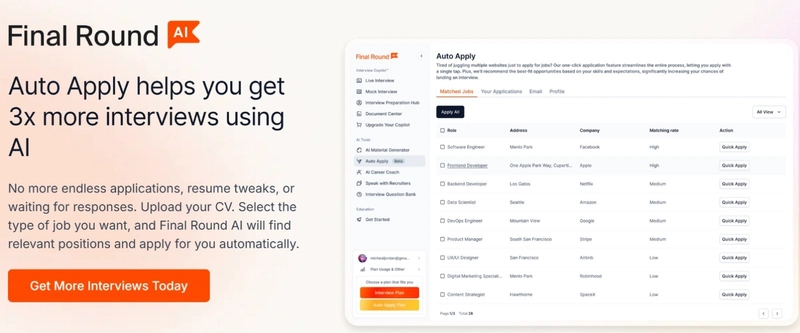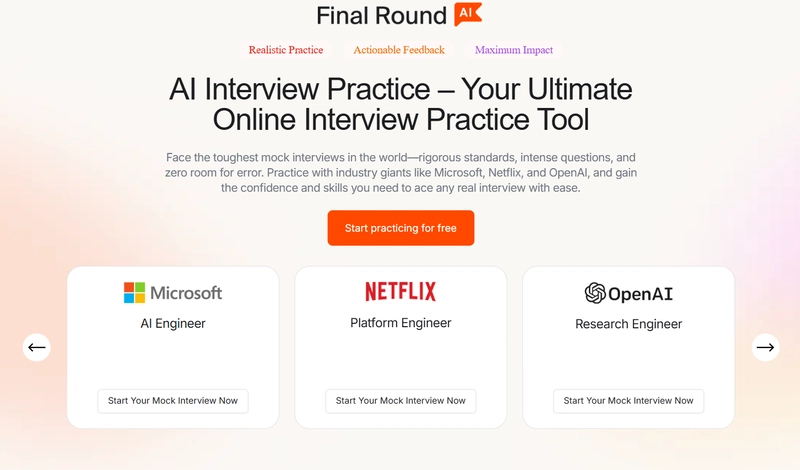Python is hotter than ever 🔥, and in 2025, companies are raising the bar even higher for devs who want to stand out. Whether you’re prepping for your next big interview 👨🏻💻 or just want to test your Python muscle 💪, you’re in the right place!
In this article, we’ve gathered 40 must-know Python interview questions, ranging from beginner basics to advanced challenges. Each question includes a brief note on why it matters, followed by a clear answer. Think you’ve got what it takes? Let’s find out!
✅ Sharpen your skills
✅ Ace your next interview
✅ Become the Python pro companies are hunting for in 2025
Ready? Let’s dive right in! 🏊♂️
👶🏻 Beginner Level (Warm-Up Round)
1. 🔑 What is Python and what are its key features?
Interviewers start here to confirm you know Python’s identity and what makes it unique in today’s ecosystem.
Answer:
Python is a high-level, interpreted language known for its readable syntax, dynamic typing, and vast standard library. It supports multiple paradigms (procedural, object-oriented, functional) and boasts automatic memory management and a large ecosystem of third-party packages.
2. ⛓ How is Python interpreted?
Understanding Python’s execution model helps explain performance characteristics and debugging approaches.
Answer:
Python code is first compiled to bytecode, which is then executed by the CPython virtual machine. This two-step process (source → bytecode → interpreter) makes Python portable but can introduce runtime overhead.
3. 📚 What are Python’s data types?
Data types form the backbone of any program, knowing them ensures you choose the best structure for each task.
Answer:
Common Python built-in types include integers, floats, strings, booleans, lists, tuples, sets, and dictionaries. Additionally, Python supports NoneType and user-defined classes.
4. 📏 What is PEP8 and why is it important?
PEP8 enforces consistent code style, which improves readability and maintainability in team environments.
Answer:
PEP8 is the Python Enhancement Proposal that defines style guidelines, indentation, naming conventions, line length, etc. Adhering to PEP8 makes code predictable and easier to review.
5. 📋 Explain the difference between a list and a tuple.
Lists and tuples are fundamental collections, knowing their trade-offs affects performance and mutability choices.
Answer:
A list is mutable (you can add, remove, or change items), while a tuple is immutable (fixed after creation). Tuples can be used as keys in dictionaries and are slightly faster due to immutability.

Try Final Round AI for FREE today! 🔥
6. 🏷️ What is the use of self in Python classes?
self is central to instance methods, misusing it leads to confusing bugs.
Answer:
self refers to the instance on which a method is called, allowing access to attributes and other methods. It must be the first parameter of instance methods but is passed automatically by Python.
7. 🧠 How is memory managed in Python?
Effective memory management prevents leaks and performance issues, especially in long-running applications.
Answer:
Python uses reference counting and a generational garbage collector to reclaim unreferenced objects. Cyclic references are cleaned up by the garbage collector’s separate cycle-detection mechanism.
8. 📄🆚📑 What is the difference between deep copy and shallow copy?
Copy semantics can introduce subtle bugs if you don’t know whether nested objects are shared or duplicated.
Answer:
A shallow copy creates a new container but references the same inner objects. A deep copy (via copy.deepcopy) recursively duplicates all nested objects, yielding a fully independent clone.
9. 🧺 What are Python's built-in data structures?
Knowing your toolbox ensures you pick the most efficient structure for each problem.
Answer:
Python provides list, tuple, set, frozenset, dict, and str as core data structures. Each has different performance characteristics and use-cases based on mutability and ordering.
10. 📦 How do you manage packages in Python?
Package management keeps environments reproducible, a must in collaborative and production settings.
Answer:
You use pip (the Python package installer) to install and manage packages from the Python Package Index (PyPI). Virtual environments (venv or virtualenv) isolate dependencies per project.
👦🏻 Intermediate Level (Now It Gets Real)
11. 🎀 What are Python decorators and how are they used?
Decorators enable reusable, clean modifications to function or method behavior, critical for frameworks and logging.
Answer:
A decorator is a function that wraps another function, adding behavior before or after its execution. You apply it with @decorator_name above the function definition.
12. 📝 What is list comprehension? Give an example.
List comprehensions provide a concise, Pythonic way to build lists, improving readability and often performance.
Answer:
List comprehension uses a single expression to create a list:
squares = [x*x for x in range(10)]
This is equivalent to a for-loop but more compact.
13. ♻️ Explain generators and yield in Python.
Generators allow you to handle large or infinite sequences lazily, saving memory.
Answer:
A generator function uses yield to produce a sequence of values one at a time. On each call to next(), execution resumes after the last yield, maintaining state between iterations.
14. 📥 What are *args and **kwargs?
These constructs allow flexible function signatures, enabling wrappers, wrappers, and DSL-style APIs.
Answer:
*args captures extra positional arguments as a tuple, **kwargs captures extra keyword arguments as a dict. They let you accept arbitrary parameters.
15. 🛑 How does exception handling work in Python?
Robust error handling is essential for building resilient applications.
Answer:
Use try/except blocks to catch exceptions, else for code that runs if no exception occurs, and finally for cleanup. You can raise custom exceptions with raise.
Try Final Round AI for FREE today! 🔥
16. 🔍 What is the difference between is and ==?
Misunderstanding identity vs. equality can cause subtle, hard-to-trace bugs.
Answer:
== tests value equality (via __eq__), while is tests object identity (same memory address). Use is for singletons like None.
17. 🧹 How do you manage memory leaks in Python?
Even with GC, lingering references or large caches can bloat memory over time.
Answer:
Identify leaks with tools like objgraph or tracemalloc, remove unintended references, use weak references, and clear caches or large data structures when no longer needed.
18. 🚀 What is a lambda function?
Lambdas let you define inline, anonymous functions, handy for short callbacks and functional APIs.
Answer:
A lambda is an anonymous function:
square = lambda x: x*x
It’s limited to a single expression and returns its result automatically.
19. 🧪 What’s the purpose of virtual environments in Python?
Isolated environments prevent dependency conflicts between projects.
Answer:
Virtual environments (via venv or virtualenv) create isolated Python installations per project, each with its own site-packages, so packages don’t collide.
20. 🔒 Explain Python’s Global Interpreter Lock (GIL).
The GIL impacts concurrency, knowing its limitations guides architecture and performance decisions.
Answer:
The GIL is a mutex that allows only one native thread to execute Python bytecode at a time in CPython. It simplifies memory management but limits CPU-bound multithreading, pushing developers toward multiprocessing or async.
👨🏻 Advanced Level (Boss Mode)
21. 🧵 How does multithreading work in Python despite the GIL?
Concurrency questions probe your ability to build responsive apps despite Python’s threading model.
Answer:
Because of the GIL, Python threads excel at I/O-bound tasks (waiting on network/disk). For CPU-bound tasks, you use the multiprocessing module or offload work to C extensions that release the GIL.
22. 🐒 What is monkey patching in Python?
Monkey patching lets you alter behavior at runtime, but can introduce maintenance nightmares if misused.
Answer:
Monkey patching dynamically modifies classes or modules at runtime, e.g.,
import module
module.func = new_func
Use sparingly and document changes to avoid unpredictable behavior.
23. 🧹♻️ How are Python’s memory management and garbage collection implemented?
Deep understanding of GC internals helps you tune performance and avoid leaks.
Answer:
Python uses reference counting for immediate deallocation plus a cyclic collector (three generations) to detect and clean up reference cycles.
24. 👨🏻🏫 Explain context managers and the with statement.
Context managers ensure resources (files, locks) are properly acquired and released.
Answer:
A context manager defines __enter__ and __exit__. The with statement calls these, ensuring cleanup:
with open('file.txt') as f:
data = f.read()
25. 🔮 What is a metaclass in Python?
Metaclasses let you customize class creation, a powerful but advanced feature for frameworks.
Answer:
A metaclass is the “type of a class.” By subclassing type, you can override __new__ or __init__ to modify class attributes at creation time.
26. ⚙️ How do coroutines differ from threads?
Coroutines enable high-concurrency I/O without threads, crucial in async frameworks.
Answer:
Coroutines use cooperative multitasking within a single thread, yielding control with await. Threads preemptively multitask, but in CPython share the GIL.
27. ⚡ What is the difference between asynchronous programming and multithreading?
Choosing the right concurrency model impacts scalability and complexity.
Answer:
Async uses a single thread and event loop to interleave tasks on I/O waits. Multithreading uses OS threads to run tasks in parallel (but still limited by the GIL for CPU-bound code).
28. 🗂️ What are data classes (@dataclass) in Python 3.7+?
Data classes reduce boilerplate for classes that mainly store data, improving readability.
Answer:
@dataclass automatically generates __init__, __repr__, __eq__, and other methods based on class annotations:
from dataclasses import dataclass
@dataclass
class Point:
x: int
y: int
29. 🚴♂️ How would you optimize a slow Python script?
Performance tuning is a key skill for production-grade applications.
Answer:
Profile with cProfile or line_profiler, optimize hotspots by using built-ins, C extensions, or concurrency (async/multiprocessing), and reduce I/O or algorithmic complexity.
30. 🔐 How does Python implement closures?
Closures capture lexical scope, a foundational concept for callbacks and decorators.
Answer:
A closure is created when a nested function captures variables from its enclosing scope. The captured variables are stored in the function’s __closure__ attribute.
👴🏻 Expert Level (Only the Brave)
31. 🤔 What are slots (__slots__) and why use them?
Slots save memory by preventing the creation of __dict__ on many instances, crucial in large-scale systems.
Answer:
Defining __slots__ = ('x','y') on a class restricts its attributes to those names and eliminates the per-instance attribute dict, reducing memory overhead.
32. 🎞 How is Python code compiled and executed internally?
Understanding the CPython pipeline helps you debug performance and bytecode issues.
Answer:
Source code → AST → bytecode → evaluation by the CPython virtual machine. You can inspect bytecode with the dis module.
33. 🌐 How would you design a scalable web application backend in Python?
Architectural questions test your ability to apply Python skills to real-world systems.
Answer:
Choose frameworks (FastAPI for async or Django for batteries-included), containerize with Docker, use async or multiprocessing for concurrency, add caching (Redis), and deploy via Kubernetes or serverless platforms.
34. 🧠 Explain the concept of memoization in Python.
Memoization caches expensive function results, speeding up repeated calls and dynamic programming.
Answer:
Implement manually with a dict or use functools.lru_cache decorator to cache function outputs based on arguments.
35. 🕳️ How does async/await syntax work under the hood?
Grasping async internals lets you debug event-loop issues and write more efficient coroutines.
Answer:
async def functions return a coroutine object. The event loop schedules coroutines, await suspends execution until the awaited future completes, resuming thereafter.
36. 📂 What’s the role of the __init__.py file?
__init__.py turns a folder into a package, affecting import behavior and module initialization.
Answer:
An empty or configured __init__.py signals Python to treat the directory as a package, you can also expose submodules and set package-level variables there.
37. ✍️ How does Python’s type hinting improve code quality?
Type hints enable static analysis, better IDE support, and fewer runtime errors in large codebases.
Answer:
Using typing annotations (e.g., def f(x: int) -> str) lets tools like mypy catch type mismatches before runtime and improves documentation.
38. 🔄 How would you create a custom iterator?
Iterators let you build custom loopable objects for domain-specific data streams.
Answer:
Define a class with __iter__() returning self and __next__() to yield the next value or raise StopIteration.
39. 🛠️ How does the descriptor protocol (__get__, __set__, __delete__) work?
Descriptors underpin property, methods, and advanced attribute management in frameworks.
Answer:
A descriptor is an object with any of these methods, when placed in a class, attribute access invokes the protocol:
-
__get__on retrieval -
__set__on assignment -
__delete__on deletion
40. 🥊 Compare Django and FastAPI. Which would you choose for a new project in 2025?
Framework choice impacts development speed, performance, and scalability of real-world applications.
Answer:
Django offers a full-featured “batteries-included” stack, ORM, admin, and auth, ideal for monolithic apps. FastAPI is lightweight, async-first, and faster for APIs. Choose Django for complex business logic and FastAPI for high-performance microservices.
🏆 How Did You Score?
- 0–10: Beginner Pythonista → Just getting started, but keep at it! 🌱
- 11–20: Intermediate Python Coder → You’re definitely getting warm! 🔥
- 21–30: Advanced Python Developer → Companies will LOVE you! 💼
- 31–40: Python Guru → Teach us, master! 👑
🎉 Final Thoughts
Python interviews in 2025 will not just be about syntax, they’ll test your problem-solving, architecture sense, and performance awareness.
No matter your score, keep learning, keep building, and you'll stand out in any technical interview! 🚀
| Thanks for reading! 🙏🏻 Please follow Final Round AI for more 🧡 |
|---|









Top comments (10)
One of the most interesting questions from the article is: ‘What is the difference between deep copy and shallow copy in Python?’ Can you explain how these two differ?
Great question! Understanding the distinction between shallow and deep copies is crucial in Python, especially when dealing with mutable objects like lists or dictionaries.
Shallow Copy: Creates a new object, but inserts references into it to the objects found in the original. This means that changes to nested objects in the copy will reflect in the original.
Deep Copy: Creates a new object and recursively copies all objects found in the original. This ensures that changes in the copy do not affect the original object.
Here's a simple example:
Output:
As you can see, modifying the shallow copy affected the original, while changes to the deep copy did not.
Thank you, Hadil....! 🙏
Your explanation is super clear and the example really helps to understand the difference between shallow and deep copies. The output comparison makes it all click perfectly!
This distinction is definitely something to keep in mind when working with nested data structures.
You're welcome 🙏🏻 If you have any specific topics or questions you'd like to see covered in future articles, feel free to let me know.
This article was really great! The questions are very comprehensive and practical, especially for those looking to enhance their Python skills and prepare for professional interviews. 👌
Thank you so much for your kind words Mahdi! 🙏🏻 I'm thrilled to hear that you found the article comprehensive and practical. My goal was to provide a resource that helps developers at various levels prepare effectively for Python interviews.
Very nice article. Thank you for sharing 🙏🙏
You're welcome 🙏🏻
I conduct interviews myself, and I must say this list looks great . I'll definitely be sharing it with my colleagues. As always, I'm a big fan of @hadil articles. Keep up the great work!👍
Thank you so much for your encouragement Sanjay. I'm so happy you like my articles 💙